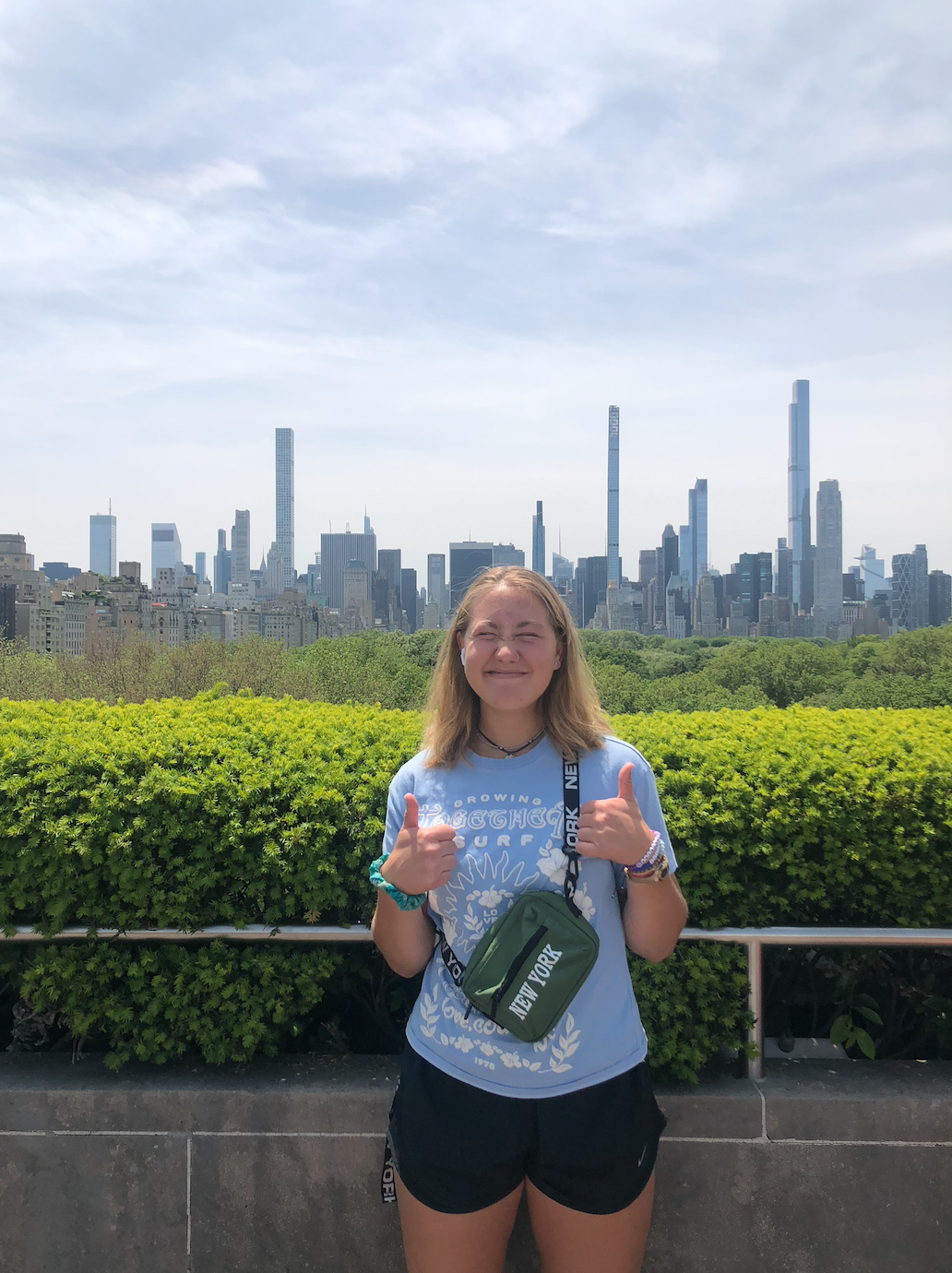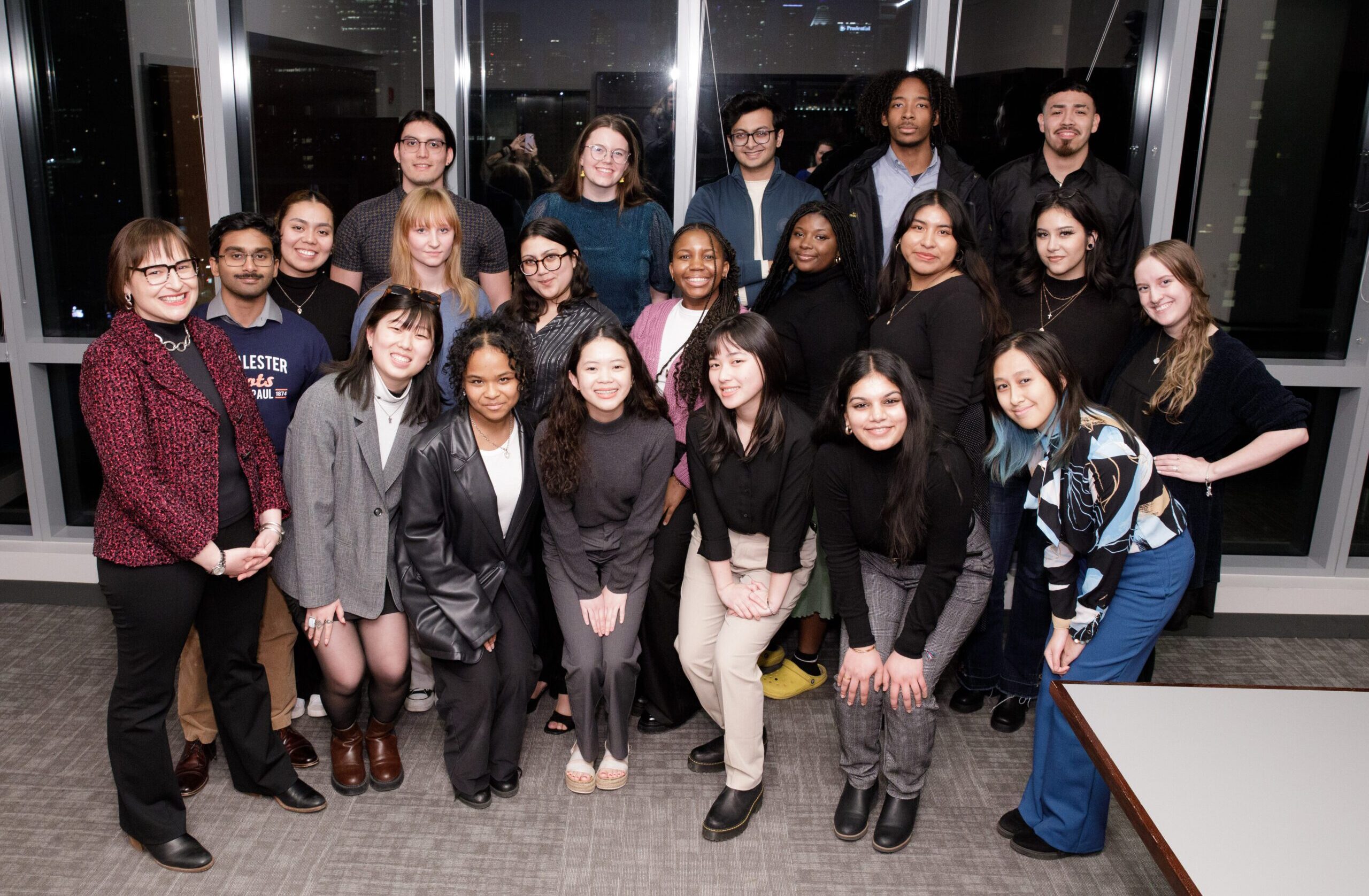“In some cases, we found rates [of childhood obesity] that were comparable to the U.S., and the U.S. has declared obesity a national epidemic, so that is concerning,” said Jessica Meyer. “I think our [project] is a good baseline for further research.”
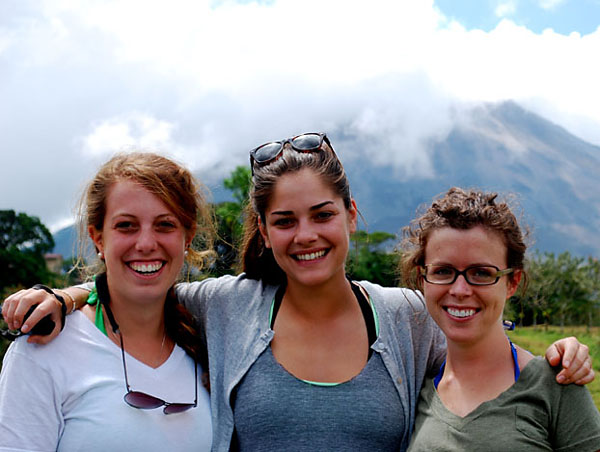 Jessica Meyer, Chloe Souza, and Maggie Swift in Costa Rica, with Volcán Arenal in the background.
Jessica Meyer, Chloe Souza, and Maggie Swift in Costa Rica, with Volcán Arenal in the background.
Photo courtesy of Maggie Swift
Meyer, a junior at Colorado College, was describing the results of a project she worked on with Macalester College students Chloe Souza and Margot (Maggie) Swift this past spring semester on the ACM Costa Rica: Field Research in the Environment, Social Sciences, & Humanities program.
For two months, the three women trekked across the Costa Rican countryside visiting schools. At each stop, they explained their project, handed out questionnaires, and then weighed and measured the children. In all, they gathered data from more than 2,600 children, from pre-schoolers up through high school seniors.
Meyer, Souza, and Swift were conducting what was probably the first sizeable study of overweight and obese children in rural Costa Rica. They designed the study to find out the rates of obesity and overweight among children, and then to correlate those rates to factors such as the children’s level of physical activity and their “media screen time” – that is, the time they spent watching television, playing video games, and using the computer.
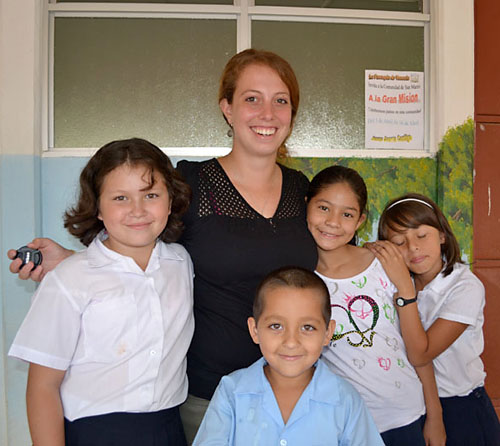 Jessica Meyer with students at San Martin School in Venecia.
Jessica Meyer with students at San Martin School in Venecia.
Photo courtesy of Jessica Meyer
Although the three students gathered their data in different geographical areas and wrote individual research proposals and final papers, they worked together to develop a common survey questionnaire and methodology. They also shared advisors – Dr. Freddy Ulate, a pediatrician who has worked with ACM students on a variety of public health-related projects, and his daughter, Dr. Diana Ulate.
The idea for the project came from Freddy Ulate. “It’s an issue that he’s seen in Costa Rica, and he saw an opportunity to have the three of us in different locations to make the project stronger,” said Souza. “I found it really helpful to be working with other people, and we all had different backgrounds within the health field.”
ACM Costa Rica Director Chris Vaughan noted that it is rare for students to collaborate so closely on a project, since the program focuses on individual research projects. In this case, though, “I think it made a lot of sense for them to compare notes and use the same survey and ways of gathering data,” he said. “On some weekends, they got together at the advisor’s summer house and had a great time and just talked about the project.”
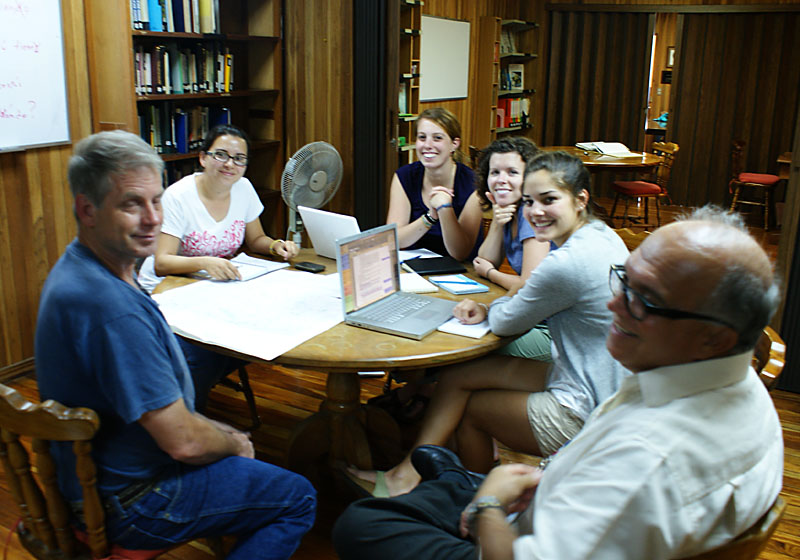 The students meeting with (from left) statistical advisor Mike McCoy and project advisors Dr. Diana Ulate and Dr. Freddy Ulate.
The students meeting with (from left) statistical advisor Mike McCoy and project advisors Dr. Diana Ulate and Dr. Freddy Ulate.
The program takes what Vaughan called a “mini-master’s thesis” approach to the projects. Students begin with a month at the ACM center in the capital city of San José, where they work with their advisors to develop and present a formal research proposal. They also take a Spanish language and culture course tailored to what they will need to know when they’re in the field. For students doing health-related projects, that includes covering topics such as medical terminology.
Then it’s off to their field sites for eight weeks – four weeks for students on the spring quarter/trimester schedule – to conduct research and gather data. Students keep in touch with their advisors throughout this phase of the program, including a meeting and progress report about halfway through. For the final four weeks of the program, they are back in San José, analyzing the data and writing a substantial research paper.
Since Meyer, Souza, and Swift would be going into schools to carry out their study, Freddy and Diana Ulate took them to meet the regional director of the Ministry of Public Education and get his permission for the project. They also traveled to meet with the school superintendents in the districts where they would be conducting the survey.
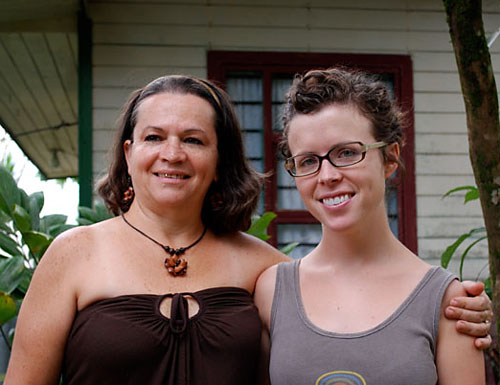 Maggie Swift with her host mother in Pital, where she lived during the field research phase of the program.
Maggie Swift with her host mother in Pital, where she lived during the field research phase of the program.
Photo courtesy of Maggie Swift
A lot of long days of fieldwork followed. Typically, the students would go to each school twice. First, they would meet the principal and teachers and explain the purpose of the research. They would also go into classrooms to hand out questionnaires to the schoolchildren and talk about the project. Another day, they would return to the school to collect completed questionnaires and to weigh and measure the children.
The questionnaire asked about the children’s birth weight and the amount of time during the week that they spent on physical activity and on media screen time. The measurements provided data for calculating Body Mass Index (BMI) and abdominal circumference, which were used to classify the children as underweight, normal weight, overweight, or obese.
“I don’t think obesity is a health issue that’s talked about much,” said Meyer, “and [the children] really had no idea of the impact of sitting around and watching a lot of video games. It was definitely interesting to talk to them about that.”
“The kids were just really curious and were always asking us questions,” Souza recalled. “Teachers were really curious, too, about why we were there, what we were doing, where we were from, and how long we were going to be in Costa Rica. Sometimes English teachers [in the high schools] would ask us to sit in on classes and explain different things.”
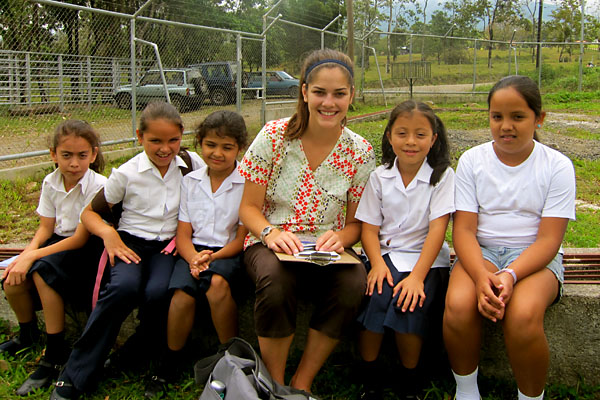 Chloe Souza with children at the Viento Fresco school.
Chloe Souza with children at the Viento Fresco school.
Photo courtesy of Chloe Souza
“The principals would pass on their enthusiasm for the project on to the teachers,” Swift added. “A lot of the schools I went to were super, super rural, so having someone there from the U.S. was really exciting. The kids would try to one-up each other in giving us little gifts or pieces of paper with pictures on them. One would have the idea to make us something – a drawing or stickers – and then all the kids would make something.”
The three students kept in touch every few days to talk about issues that came up in administering the survey. They also met with the Ulates partway through the data collection to make sure the project was on track. While the focus of the semester was on the research, it’s clear that the cultural and language immersion was very valuable, as well.
“The rural stay aspect and doing all my research was a phenomenal experience,” said Meyer. “For the most part, on a day-to-day basis I was by myself doing research in schools, and all the communication I had was in Spanish with Costa Rican children and the teachers. The survey was in Spanish. The presentations I had to give to teachers and superintendents about the research I was doing were also in Spanish. So it was a kind of extreme immersion, but in a topic I was really interested in. It was refreshing to have a really practical application of the language.”
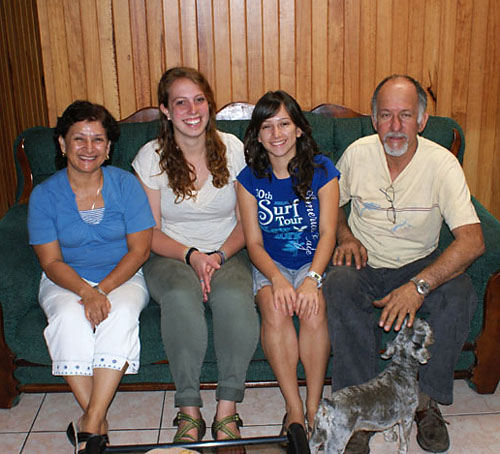 Jessica Meyer with her host family in Venecia.
Jessica Meyer with her host family in Venecia.
The students returned to San Jose with lots of data. Among them, they had collected measurements and answers to the 20-question survey from more than 2,600 children. Fortunately, they had entered most of the data onto their computers during the evenings when they were in the field. Now it was time to start crunching the numbers.
“We knew generally how we wanted to analyze it before we left to start collecting data,” Swift said. “We wanted to find the prevalence [of obesity among the children] and we wanted to do that based on the BMI’s we collected and the abdominal circumferences. Then we wanted to look at these risk factors [of media screen time and physical activity]. It was a matter of putting all of our data into the statistical programs, which took a long time, and then determining exactly which tests were best for what we wanted to do.”
The program’s statistical advisor, Mike McCoy, worked with them to analyze the data, with help from Diana and Freddy Ulate. “It was definitely overwhelming at times to figure out how to go about analyzing all that [data], but our advisors were really helpful in organizing it,” said Meyer.
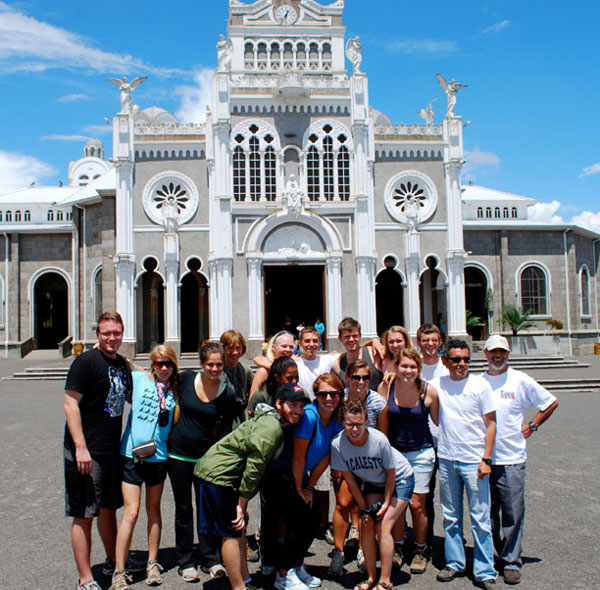 Spring 2011 participants at the Basilica in Cartago during a program field trip.
Spring 2011 participants at the Basilica in Cartago during a program field trip.
Back on campus in the fall, the students had time to reflect on the program. For Souza, who is now considering a career in public health, the program caused her to change her summer plans as soon as she returned home. “Doing my work in Costa Rica, more than anything, showed that I want to be out in the field and working hands-on with children,” she said. “I really enjoyed having the contact with children and teachers in the school and building those relationships. That inspired me this summer to do a lot more hands-on fellowship than I was originally going to do in the lab.”
“Overall, it was a really wonderful experience to have,” Meyer said. “Even if it got frustrating, at least it was our work and we were in control of our research schedules and in control of where the research went, so I think that we all felt that that was a really good experience to have.”
Swift said that being in Costa Rica reinforced that she wants to work in the medical field and find opportunities to volunteer, both internationally and in the U.S. “Looking back at it,” she concluded, “the memories just get fonder and fonder.”
Links:
- Costa Rica: Field Research in the Environment, Social Sciences, & Humanities (spring semester and spring quarter/trimester)
- Costa Rica: Language, Society, & the Environment (fall semester)
- Research project abstracts for Jessica Meyer, Chloe Souza, and Margot (Maggie) Swift
- ACM field research advisors and potential areas of research
- Student blogs for the ACM Costa Rica: Field Research program






